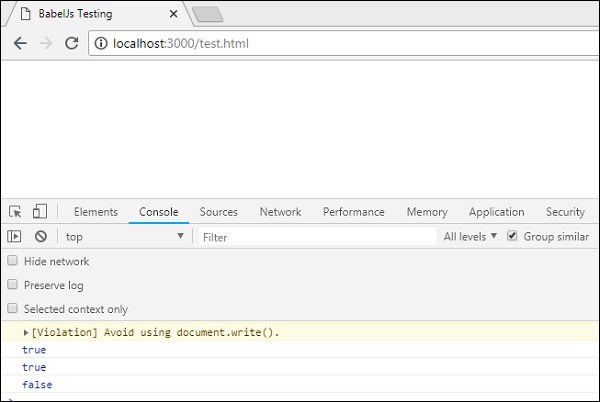- BabelJS-将ES8功能转换为ES5
- BabelJS-将ES8功能转换为ES5(1)
- ES7-新功能
- ES7-新功能(1)
- BabelJS-将ES6模块转换为ES5(1)
- BabelJS-将ES6模块转换为ES5
- es7 - Javascript (1)
- es7 - Javascript 代码示例
- BabelJS-示例
- BabelJS-示例(1)
- BabelJS-使用BabelJS和Gulp
- BabelJS-使用BabelJS和Gulp(1)
- es5 参数 (1)
- JavaScript ES5 对象方法
- JavaScript ES5 对象方法(1)
- BabelJS教程
- BabelJS教程(1)
- ES5与ES6
- ES5与ES6(1)
- es5 参数 - 任何代码示例
- 讨论BabelJS
- 讨论BabelJS(1)
- BabelJS-概述
- BabelJS-概述(1)
- BabelJS-CLI
- BabelJS-CLI(1)
- ES5 和 ES6 的区别
- ES5 和 ES6 的区别(1)
- BabelJS-环境设置(1)
📅 最后修改于: 2020-10-27 03:18:31 🧑 作者: Mango
在本章中,我们将学习如何将ES7功能转换为ES5。
ECMA Script 7添加了以下新功能-
- 异步等待
- 求幂运算符
- Array.prototype.includes()
我们将使用babeljs将它们编译为ES5。根据您的项目要求,也可以在任何ecma版本中编译代码,例如ES7至ES6或ES7至ES5。由于ES5版本最稳定并且可以在所有现代和旧版浏览器上正常工作,因此我们会将代码编译为ES5。
异步等待
异步是一个异步函数,它返回一个隐式的Promise。诺言要么被解决,要么被拒绝。异步函数与普通标准函数相同。该函数可以具有await表达式,该表达式将暂停执行直到返回promise,并且一旦获得promise便继续执行。仅当函数异步时,等待才有效。
这是有关异步和等待的工作示例。
例
let timer = () => {
return new Promise(resolve => {
setTimeout(() => {
resolve("Promise resolved after 5 seconds");
}, 5000);
});
};
let out = async () => {
let msg = await timer();
console.log(msg);
console.log("hello after await");
};
out();
输出
Promise resolved after 5 seconds
hello after await
在调用计时器函数之前添加了await表达式。计时器函数将在5秒钟后返回承诺。因此,等待将暂停执行,直到解决或拒绝计时器函数的承诺,然后再继续。
现在让我们使用babel将以上代码转换为ES5。
ES7-异步等待
let timer = () => {
return new Promise(resolve => {
setTimeout(() => {
resolve("Promise resolved after 5 seconds");
}, 5000);
});
};
let out = async () => {
let msg = await timer();
console.log(msg);
console.log("hello after await");
};
out();
命令
npx babel asyncawait.js --out-file asyncawait_es5.js
BabelJS-ES5
"use strict";
var timer = function timer() {
return new Promise(function (resolve) {
setTimeout(function () {
resolve("Promise resolved after 5 seconds");
}, 5000);
});
};
var out = async function out() {
var msg = await timer();
console.log(msg);
console.log("hello after await");
};
out();
Babeljs不编译对象或方法。因此这里使用的承诺不会被转译,而是按原样显示。为了在旧的浏览器上支持承诺,我们需要添加代码,这些代码将支持承诺。现在,让我们如下安装babel-polyfill-
npm install --save babel-polyfill
应该将其另存为依赖而不是dev依赖。
要在浏览器中运行代码,我们将使用来自node_modules \ babel-polyfill \ dist \ polyfill.min.js的polyfill文件,并使用script标记进行调用,如下所示-
BabelJs Testing
运行上面的测试页面时,您将在控制台中看到如下所示的输出

求幂运算符
**是ES7中用于取幂的运算符。以下示例显示了ES7中相同代码的工作原理,并且使用babeljs对其代码进行了转译。
例
let sqr = 9 ** 2;
console.log(sqr);
输出
81
ES6-求幂
let sqr = 9 ** 2;
console.log(sqr);
要转换幂运算符,我们需要安装一个插件,如下所示:
命令
npm install --save-dev babel-plugin-transform-exponentiation-operator
将插件详细信息添加到.babelrc文件,如下所示:
{
"presets":[
"es2015"
],
"plugins": ["transform-exponentiation-operator"]
}
命令
npx babel exponeniation.js --out-file exponeniation_es5.js
BabelJS-ES5
"use strict";
var sqr = Math.pow(9, 2);
console.log(sqr);
Array.prototype.includes()
如果传递给它的元素存在于数组中,则此功能为true;否则为false。
例
let arr1 = [10, 6, 3, 9, 17];
console.log(arr1.includes(9));
let names = ['Siya', 'Tom', 'Jerry', 'Bean', 'Ben'];
console.log(names.includes('Tom'));
console.log(names.includes('Be'));
输出
true
true
false
我们必须在这里再次使用babel-polyfill,因为include是数组上的一种方法,不会被编译。我们需要其他步骤来包括polyfill,以使其在较旧的浏览器中运行。
ES6-array.includes
let arr1 = [10, 6, 3, 9, 17];
console.log(arr1.includes(9));
let names = ['Siya', 'Tom', 'Jerry', 'Bean', 'Ben'];
console.log(names.includes('Tom'));
console.log(names.includes('Be'));
命令
npx babel array_include.js --out-file array_include_es5.js
Babel-ES5
'use strict';
var arr1 = [10, 6, 3, 9, 17];
console.log(arr1.includes(9));
var names = ['Siya', 'Tom', 'Jerry', 'Bean', 'Ben'];
console.log(names.includes('Tom'));
console.log(names.includes('Be'));
要在较旧的浏览器中对其进行测试,我们需要使用polyfill,如下所示-
BabelJs Testing
输出
